Photo from Deutsches Bundesarchiv via Wikipedia
I’ve noted before how World War II continues to provide an endless bounty of fascinating stories and inspiration for writing. Perhaps because of this, there hasn’t been much impetus in the English-speaking world to turn its attention away from the battles that the Western powers fought in North Africa, Italy, France and the Pacific. In fact, the only dent made by the war between the Soviet Union and Germany in cultural consciousness that I can remember was the moderately successful movie, Enemy at the Gates, about the Battle of Stalingrad.
One of the great joys of writing historical fiction is doing the research. To be able to shed light on hidden corners and discover things you wouldn’t normally have a chance to.
Beyond learning about a conflict that is underexposed in the West, what most interests me is reading real life accounts of people who lived through it. While that generation increasingly succumbs to time, we’re lucky to have their memoirs. We are luckier still that more and more outside of the Western experience are being translated into English. Reading their stories is very different from our familiar concept of war being to do your part “over there” and then simply come home. For these people, their homeland was the battlefield. Any higher motivations in these memoirs are clouded by the scale of horror perpetrated in a war between murderous dictators.
One of those dictators, Josef Stalin, is often attributed with this quote: A single death is a tragedy. A million deaths is a statistic. It is important to read these accounts of the very human struggle beneath those statistics, to move past the sheer scale of the war and remember their individual stories. Here are four memoirs of the Eastern Front that deserve a wider audience for their unique points of view, from both sides of the conflict.
Bounden Duty, by Alexander Stahlberg
Who Wrote It?
Alexander Stahlberg was an officer in the German army who moved in very high circles.
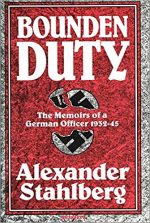 What Story Does It Tell?
What Story Does It Tell?
With service dating from before the war, Stahlberg was part of the traditional officer class of the German army. The privileged son of a factory owner, he joined the army initially to avoid being forced into the Nazi party. He became involved with a conservative faction that opposed Hitler, but also feared communism. When war comes, he set aside many of his reservations to serve his country, from the invasion of Poland through to the final surrender of Germany. His experience of war includes time at the front, acting as aide to one of Germany’s foremost military minds and as part of the resistance to Hitler.
What Makes It Unique?
Because of his access to high levels of command through both military and family links, this memoir opens a window on the ultimately futile resistance efforts of members of the German military. Stahlberg was a member of the Prussian aristocratic class whose sense of duty and honour was exploited by Hitler and enabled monstrous evil.
I got the sense when reading Stahlberg that he continued to be torn between his sense of duty and his sense of what was right. In the book, he is clear that Nazi atrocities were known and that there were opportunities to stop them. Nonetheless, he also seems to somewhat gloss over the way many of his comrades, who professed repugnance at Hitler, did little to stop him out of a misguided code of honour. In particular, his portrait of Field Marshal Erich von Manstein, arguably the outstanding military strategist of World War II and mastermind of the conquest of France, seems to almost excuse the way he enabled war crimes to be committed under his command, apparently due to a sense of disbelief that such things could happen. But for the most part, Stahlberg is matter of fact in his recounting, even when telling of the time he was admonished by a fellow anti-Nazi for not shooting Hitler when he had a chance. Stahlberg presents his account and seems content to let history decide.
The Forgotten Soldier, by Guy Sajer
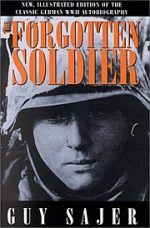 Who Wrote It?
Who Wrote It?
Guy Sajer claimed to have been (more on that below) a member of the Wehrmacht’s elite Großdeutschland Panzergrenadier Division.
What Story Does It Tell?
Drafted in 1942, Sajer was sent to fight against the Soviet Union, beginning with the Battle of Stalingrad all the way through to the fall of Germany in 1945. The memoir ends when he is processed and finally released back home from a POW camp and touches on the overlooked subject of German POW’s who were forced into labour by the Western Allies after the war.
Why Is It Unique?
Guy Sajer does not fit the mold of the German war machine. First off, he is half-French and was living in France at the start of the war. He is not a Nazi, but he is anti-communist. He is not an efficient killer, but a scared, confused infantryman dragged from place to place.
Neither does Sajer’s memoir fit the mold of most accounts of the war. It is a meditation, rather than a recounting of events. An atmosphere of violence, fear, confusion and bleakness, punctuated by occasional moments of humour and love, pervade the writing. It paints particularly well a picture of fighting on the Eastern Front, especially in the terrible winter.
Stories of the average soldier in his unity remind us of the polyglot nature of soldiers conscripted from all over occupied and allied territories to fight for the Reich. This book tells of a very human experience of the war from the German side, albeit one not influenced by Nazi indoctrination. Whatever ideals or sense of adventure Sajer might have had at the beginning, they turned into hopelessness against Soviet onslaught late in the war, until ultimately, there was only the will to survive.
Accused of fabricating his story due to inconsistencies in events, Sajer (a pen name) responded that he was making a deeply personal narrative, one that emphasized recollection rather than recording history. His writing feels like an impressionist painting. Those impressions stood the scrutiny of veterans who were there, so much so that The Forgotten Soldier is on the US Army’s recommended reading list.
A Writer at War, by Vasily Grossman
Who Wrote It?
During the Great Patriotic War, as World War II is known to the former Soviet Union, Vasily Grossman was the main 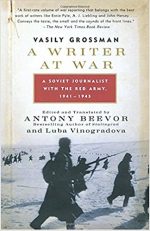 “man on the ground” for Red Star, the official military newspaper.
“man on the ground” for Red Star, the official military newspaper.
What Story Does It Tell?
Not directly a memoir, this is a collection of articles, notes and diary entries written by Grossman throughout the conflict.
What Makes It Unique?
Given his position, Grossman was one of the key voices in the Soviet media apparatus. This does not mean that he was an unthinking propaganda mouthpiece. Grossman’s instinct for stories of human frailty and resilience often clashed with censorship and official desires for mythmaking.
Fortunately, many of his dispatches and personal writings were preserved and translated into English for this memoir. Included are candid accounts of Soviet soldiers and civilians, as well as some of the earliest reporting on the Holocaust. Grossman’s first-hand account and eyewitness interviews about the Treblinka death camp were used in evidence at the Nuremberg trials. A Jew whose mother had been murdered by Nazi occupiers, Grossman was nonetheless sensitive to the suffering of innocents on both sides. It is unfortunate that after the war, he ran afoul of Soviet censors for his “everyman” style of depicting the Red Army. He also got into trouble for attempting to highlight Nazi atrocities against the Jews, which didn’t fit with the official Soviet view that cast the war as a struggle between fascism and communism.
As the experience of war often does, these stories mix humour with horror, triumph with tragedy. They are stories of simple men and women caught up in larger events and give a human face to the Soviet “hordes” that we’ve been conditioned to expect from past Western histories of the Eastern Front.
Red Sky, Black Death, by Anna Timofeyva-Yegorova
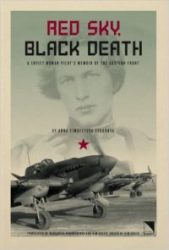
Who Wrote It?
Anna Yegorova was a ground attack pilot, the only woman pilot in her regiment.
What Story Does It Tell?
Before the war, Yegorova was a construction worker who helped build the Moscow subway. In her spare time, she took up flying, though her hopes of being a flight instructor were interrupted by the persecution of her brother during Stalin’s purges. When war came, she wanted to do her part, and her persistence paid off with an assignment as a liaison pilot for the Air Force. She later transitioned into a ground attack pilot, flying the deadly Il-2 Sturmovik, known as the “Black Death” by the Germans. After dozens of harrowing missions, she would eventually be shot down and captured. She spent the remainder of the war in a concentration camp, waiting for death. When liberation came, her suffering didn’t end. Stalin ordered that all prisoners of war be treated as traitors. She was imprisoned and interrogated and even after release, she was harassed and discriminated against for the black mark on her record. Decades later, with the Soviet Union under a new regime, she finally received her due and was awarded her nation’s highest honour.
What Makes It Unique?
Although there were many women who served in frontline combat roles for the Soviet Union during the war, this was almost unheard of in the West.
In my review of this memoir in a previous blog post, I’ve already expounded at length about how good a read Yegorova’s account is. Her story is not only filled with fascinating details of her life as a model worker, aviator and combat pilot, it is also a gripping and emotional tale. It’s perhaps the most compulsively readable account on this list.
To finish off, I want to add one book that I have yet to read. The Unwomanly Face of War is a collection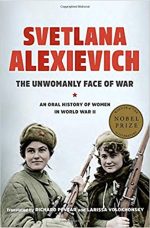 of first-hand accounts documented by Nobel Prize Winner Svetlana Alexeevich. Between 1978 and 2004, Alexeevich interviewed over two hundred Soviet women on their experience of the war, both combatants and non-combatants. Composed of accounts frequently suppressed by the “official history”, now translated and available in English for the first time in 2015, this book promises to bring their crucial experiences to life.
of first-hand accounts documented by Nobel Prize Winner Svetlana Alexeevich. Between 1978 and 2004, Alexeevich interviewed over two hundred Soviet women on their experience of the war, both combatants and non-combatants. Composed of accounts frequently suppressed by the “official history”, now translated and available in English for the first time in 2015, this book promises to bring their crucial experiences to life.
For those who want to learn more basic background on the war between Soviet Union and Germany, stay tuned for a new series of Primers.
One thought on “Reading List: Memoirs of War on the Eastern Front”